|
| Featured Article Archive 2009 |
|
|
| December 2, 2009 |
Show Box
Grooming Tips
by Heggelund Training |
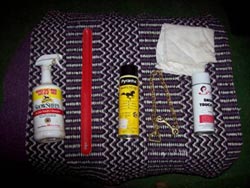 |
It is show season again, and so it is now time to clean out that grooming box and get ready for the 2010 show season. When attending shows, it is important to be prepared for anything that may happen. Sometimes this means taking extra steps to make sure the grooming box is equipped with all of the necessary items.
|
In our show box at Heggelund Training we start with the basics:
-A curry comb, hard brush, and finishing brush (soft brush). These are used on a daily basis in our barn to keep the horses' coats healthy and clean. So they are just as important at a show.
-A hoof pick should always be carried with anyone who owns a horse. Whether showing, trail riding or just working in the arena, we always have a hoof pick accessible. Keeping stones and other objects out of your horse's hooves will prevent injuries.
-A water bucket: it's a good idea to keep at least one bucket in the trailer, but we always carry an extra bucket in case of breakage or if I need it to wash or groom. During the upcoming months (both winter and summer) it is important to keep horses hydrated.
-Lunge Line and Chain: Often, out training barn is showing young horses who have never been to a show. We always keep a longeline in the tack box to get the morning friskiness out of the horses. If it is routine to longe a horse before a ride, youit is best to keep that routine in the show environment. The chain can be used in case a little leverage is needed for control on the lunge line. But only use a chain if the horse is used to it.
(As trainers, we do not like to change things up at a horse show; meaning if I have never used a chain to lunge my horse at home I would not want to start at the show.it could bother the horse and they do not know how to react to the new situation. Keeping our horse calm and relaxed in a show environment is one of our biggest goals.)
-Fly Spray- Most commonly, summer is the season for those pesky flies. Fly spray just helps keep the horses more comfortable. Keeping a clean stall or trailer space clear of manure will also help control flies.
-Baby wipes and baby oil: Baby wipes are used to keep yourself clean and baby oil is used to shine your horse's face before a halter class. If you use baby oil for halter or showmanship and you are showing outdoors, wipe it off after your class so it does not cause a sunburn. There are other products on the market such as Face Glow that are just as good.
-Grooming rags or sponge: Extra rags are always helpful to keep competitors and horses clean; there are endless uses, like cleaning off those boots before entering a class, wiping alfalfa slober from the horse's mouth, shining up the show silver, or wiping an exhibitor's brow on a 100 degree show day!
-Showsheen or Laser Sheen- this is just to give your horse an extra shine before entering a class it is not necessary, but good for a before show touch up.
Optional things one might include in a show grooming kit are baby powder for white markings, and banding or braiding supplies. Waterless horse shampoo can be useful in a grooming kit for those horse owners who live in cold winter climates. Always keep a human and an equine first aid kit in the trailer or groom box. Band-Aids and vet wrap are always handy.
Extra handy items: Bag of Chicago screws, garden hose, extra girth, extra halters and lead ropes.
For more information about Heggelund Training, please contact them at
760-705-7257 or email vanheggelund@yahoo.com .
Or Visit at www.heggelundtraining.com/ |
|
October 10, 2009
Thrifty Horse Consignment Shoppe
What treasures will
you find??
|
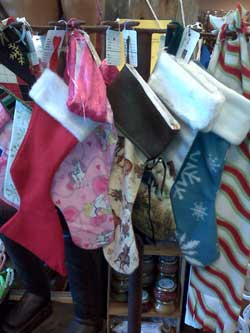 |
The great thing about this little treasure of a consignment shop is that you never know what you will find on any given day. Real bargains and hard to find items turn up when you least expect it at Thrifty Horse in Norco. Just the other day a customer was thrilled to find hand sewn, horse-themed holiday stockings - she bought a set of four for all of her horses! Plus, don't forget the fun of haggling! The prices of many of the items brought in on consignment can be negotiated, and the helpful staff at Thrifty Horse will make the call right then to see if the lower price is accepted by the Seller.
Not only do buyers seek and find treasures at Thrifty Horse, but so do consignors! Especially around the holidays, it is a great time to take inventory of those items no longer in use and bring them into the store. Thrifty Horse staff will assist in pricing items as they have the expertise to know what the "going rates" would be, but they are also flexible in letting the seller name their price to see if the item will sell. This process truly reflects what the market will bear, and many sellers use their cash earned for their own holiday shopping or expenses. |
Thrifty Horse Owner Fran Klovstad has taken this well known equine consignment store to another level since purchasing it in 2005. With the recent move to the new western-themed location on 6 th Street in Norco, Thrifty Horse has found a convenient home among many other horse businesses on this main equine thoroughfare. The great location, coupled with customer-friendly store hours seven days a week make Thrifty Horse the first choice for horse owners.
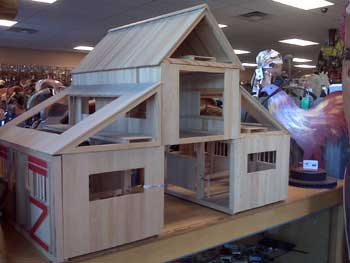
|
Furthermore, Thrifty Horse is making a name for the variety of new name brand items also available in stock at the store. Chances are if you can't find it on consignment, you can still find it at Thrifty Horse as they carry full lines of new products in both Western and English disciplines. Brands like Kensington, Ariat, Ovation, Toklat, Circle Y, Cashel, and Breyer are just a few which signify the quality found at Thrifty Horse.
Make sure to check out their new "Mini station," where the store now carries halters, blankets, bridles, bits, show tack, saddle pads, driving harnesses and more for miniature horses.
So whether it's that hard to find draft horse bridle, a large selection of saddles or the best deal in town that you're seeking, Thrifty Horse Consignment Shoppe in Norco has it all. Give us a call today or better yet, stop in and browse around the store.you never know what treasure you will find! |
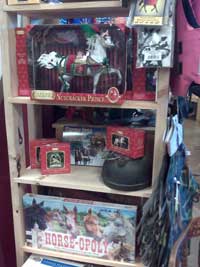 |
Thrifty Horse
951-280-0294
Store Address:
960 Sixth Street, #103B, Norco, CA 92860
New Holiday Season Store Hours:
Sunday - Thursday
9 am to 6 pm
Friday & Saturday
9am to 8pm |
|
| ~ June 9, 2009 ~ |
| Meeting a Legend |
This month's Featured Article is a Question & Answer segment from a young equestrian named Emilee Panunzi. She has a great story about her recent experience meeting Debbie McDonald and Brentina.
Famed Dressage team Debbie and Brentina are perhaps the most decorated US horse and rider team. During their fourteen year partnership, the team has reached tremendous success. Just a few highlights include: World Equestrian Games Team Silver and Bronze Medals; 2004 Olympics Team Bronze Medal winners; 2005 Farnam/Platform USEF Horse of the Year; in 1999, Debbie was named the Equestrian of the Year by the American Horse Show Association (now the USEF) and Female Equestrian Athlete of the Year by the US Olympic Commitee. Interestingly, Brentina was purchased at an auction in Germany in 1994. Since then, the pair have won the hearts of many horse lovers, both old and young.
In this Featured Article, we hear from the perspective of one young equestrian as she attends an event of a lifetime. |
|
Q: How did you come to meet Debbie MacDonald and Brentina (when, where, why?)?
A: I got to go to have the great experience to go to the Rolex World Cup where Brentina had her retirement ceremony. My mom got me tickets for Easter as a surprise and I would greatly recommend going again! The retirement ceremony consisted of Brentina entering the indoor arena with great applause. Debby McDonald rode her into the arena and came to a halt in the middle. A quick video of Brentina's accomplishments was shown and it started to make everyone cry! Brentina was such an awesome horse! After the video, brentina's saddle was taken off and she had a blanket put on that stated all of her accomplishments and a bed of roses put over her shoulders. The announcer said a quick speech goodbye and then the song "Respect", Brentina's song, was played and she immediately started her dressage movements to the song! It was very funny! She then was passed to a groom and left the arena. There was not a dry eye in the house! I then got to meet Debbie McDonald after the ceremony! This was so cool! I was second in line and was very nervous about meeting this Olympian rider! She ended up being very nice and encouraged me to never give up with my riding career! This experience was one of the best experiences of my life!
Q: List three things you learned about this legend of a horse.
A: I learned that Brentina actually had a major colic surgery a few weeks before coming to the World Cup but still came even though she was recovering! She has to be a strong horse to do that. Also I learned that Debbie McDonald didn't get to go tot the Olympics with Brentina until she was in her fifty's. Another thing is that Brentina is now almost 20 but was still showing up until the World Cup! |
Q: Were you close enough to touch Brentina?
A: Unfortunately, I was not close enough to touch her! Only the people "backstage" got that wonderful experience!
Q: What is the most memorable moment you have of meeting Debbie MacDonald?
A: I have big dreams of becoming a dressage Olympian when I am older and I told this to Debbie McDonald and she said that I should keep following my dreams even if times get tough! This advice will stay with me forever!
Q: Were you able to see any of the medals won by this extraordinary team?
A: The audience, except the ones in the video we watched of Brentina, saw no medals. Although this was very disappointing, I loved going to the World Cup!
Q: Were you able to ask Debbie any questions, and if so what did you ask and what was the reply?
A: I was actually too nervous to ask questions! My mom did for me though and she asked what it really took to be an Olympian and Debbie replied that it took dedication!
Q: Did you get to see Brentina perform?
A: No I did not get to see Brentina perform because of the major colic surgery she had a few weeks before coming to the World Cup. We did get to see Debbie McDonald ride Brentina at a walk through the arena for the last time.
Q: What kind of souvenir did you take away from this event?
A: The souvenir I got is very special to me. It is an I Love Brentina shirt that I got signed by Debbie McDonald! I could say it is like my prized possession!
Q: What is your background with horses a) your age b) how many years have you been riding c) what is your favorite discipline of riding d) what kind of horses do you own?
A: I have been riding since I was six and I am thirteen today. I started riding at the Camp Pendleton Base Stables and I am now riding with Kimberley Monk. Dressage is definitely my favorite type of riding! I think it challenges your mind and you have to be physically active to ride dressage. I own three thoroughbreds that were all rescued from the track, a quarter pony, and an appendix that I use for dressage. They all mean so much to me and without them I don't know what I would do! |
|
| ~ May 15, 2009 ~ |
Is your horse farm threatened by development?
Do you know of a breeding farm that has been replaced by a mall?
Has your community lost a horse show venue to condominiums?
Are your riding trails being closed off one by one? |
| Ask Congress to Make Conservation Tax Incentives Permanent |
Congress recently extended a tax incentive that enables horse farms, ranches, equestrian centers and moderate-income landowners to get a significant tax benefit for donating a conservation easement on their land. This law has helped land trusts conserve about a million acres a year since 2006. We need the horse community’s help to make this a permanent part of our conservation toolbox!
Conservation easements allow private landowners to permanently retire development rights to protect significant natural resources. The new tax incentive opened the door to voluntary, landowner-led conservation on millions of acres of important wildlife habitat and scenic open space across the country. Open space is integral to horse owners and breeders, no matter their discipline. If we stand together with other conservation groups, we can save pastures and trails!
How the Tax Incentive Works
The renewed incentive helps landowners of modest means choose conservation by:
• Raising the maximum deduction a donor can take for donating a conservation easement
from 30% of their adjusted gross income (AGI) in any year to 50%;
• Allowing qualified farmers and ranchers to deduct up to 100% of their AGI; and
• Increasing the number of years over which a donor can take deductions from 6 years to
16 years.
Under prior law, an agricultural landowner earning $50,000 a year who donated a
conservation easement worth $1 million could take a total of no more than $90,000 in tax
deductions! Under the new law, that landowner can take as much as $800,000 in tax
deductions – still less than the full value of their donation, but a significant increase.
Spread the word to landowners with our Grassroots Toolkit: www.lta.org/policy/policy-toolkit
Widespread Equine & Agricultural Community Support
Legislation making the incentive permanent had 183 House and 28 Senate cosponsors in the
110th Congress. More than 1,700 land trusts around the country and a remarkably diverse
coalition of agricultural and equine organizations are coming together to support this effort.
The list is still growing…add your organization today!
American Farmland Trust
American Forest Foundation
American Quarter Horse Association
Breeders’ Cup Limited
Conservation Force
Equestrian Land Conservation
Resource
Kentucky Thoroughbred Owners &
Breeders
Land Trust Alliance
Master of Foxhounds Association
Montana Land Reliance
National Cattlemen’s Beef Association
National Conference of State Historic
Preservation Officers
National Trust for Historic Preservation
NatureServe
Partnership of Rangeland Trusts
Piedmont Environmental Council
Scenic America
The Nature Conservancy
The Trust for Public Land
The Vital Ground Foundation
The Wildlife Society
Five Ways Your Members of Congress Can Help Right Now
• Ask Senators and Reps. to cosponsor legislation making the incentive permanent:
o Representatives can cosponsor by contacting Travis Robey in the Office of Rep.
Mike Thompson (D-CA) or Wyatt Stewart in the office of Rep. Eric Cantor (R-VA).
o Senators can become original cosponsors of legislation to be introduced by
Senator Max Baucus (D-MT) by calling Jo-Ellen Darcy at the Finance Committee.
• Ask Representatives to join the Land Conservation Caucus:
o Contact: Rep. Murphy (D-CT)—Jesse Young, Rep. Heinrich (D-NM)—John Blair,
Rep. Gerlach (R-PA)—Ben Stolzfoos, or Rep. Pitts (R-PA)—Lauryn Schothorst.
• Invite Members of Congress to attend a trail ride, horse show, three day event, hunter
pace, endurance meet, or similar event, to show them how important the horse community
is to their district, and how open space impacts equestrian community activities. There’s
no better place to build relationships with your elected officials than on the back of a horse,
in the breezeway of a barn, or leaning up against a pasture rail.
o For ideas, templates and advice visit: www.lta.org/policy/lobbying101/meet
• Offer them a way to take credit for renewing the incentive! Offer to draft an article on the
incentive for their constituent newsletter, get a joint op-ed placed in a local newspaper or
arrange for an interview with agricultural press in their district.
• Ask your Representative to personally call Ways & Means Committee Chairman Charles
Rangel and convey support for making the easement incentive permanent.
The Land Trust Alliance
The Land Trust Alliance is a national conservation organization that works to conserve places
people love by strengthening land conservation across America. The Alliance works to secure
public policies on a national scale that help more than 1,700 local, regional and national
conservation nonprofits increase the pace of land conservation. The equestrian community is
a large part of the open space community, and the Alliance is here to help you maintain open
space and the way of life that goes along with the proper stewardship of land. |
For more information about the tax incentive, visit:
www.lta.org/easementincentive/
or contact equine community
specialist Jessica Schley at Email or 202-638-4725 x349 |
|
| ~ March 30, 2009 ~ |
Trail Travels to McCall Park, San Jacinto Mountains
By Sherli Leonard |
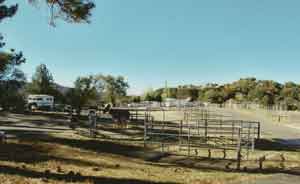 |
Recreational trail riding sweetens the connection between horse and rider as they take to rambling single-track trails in mountains, deserts, canyons, and hills, far from the chaos of civilization. Southern California offers a bounty of trails and camping opportunities, and an absolute “must do” is McCall Equestrian Park in the San Jacinto Mountains.
Built exclusively for equestrians and their four-legged companions, McCall is a Riverside County Park with about 50 pipe corrals and camping facilities for tent campers and RV users. Twenty miles from Hemet, 80 miles from Los Angeles, 90 miles from San Diego area, it is centrally located for all Southern Californians. Northern Californians should make this one of their destinations for a longer excursion. Most importantly, it has trails, trails, and more trails. |
My riding buddy, Tracey, and I camped for three nights in mid-October in a quiet, private setting right where the foothills meet the mountains.
We and our horses put in four leisurely rides and explored a good portion of the trails. We didn’t encounter any mountain bikers, and for good reason: most trails are far too rugged for bicyclists. That’s a plus. But the trails also challenge an inexperienced horse or rider. |
In the area around the park, the trails roam over a large grassy meadow with huge pines scattered around. We rode twice all over these trails, criss-crossing our paths, and feeling completely relaxed. But you can ride for about only an hour before you have run out of new trails to try. It’s a pleasant environment. We let the horses graze, caught sight of a buck bounding up the hillside, and felt the temptation to play hide and seek.
Any longer ride means climbing out of the lower area to the much higher region around the little town of Idyllwild. Here’s where the tricky footing comes. Every up-hill trail climbs hard and fast, twists and turns, and features large loose rocks that lie in wait to grab the horses’ hooves and legs. And every uphill climb means a downhill trip, equally treacherous.
When we rode, the trails were in excellent condition, not having experienced a significant rainfall for a few months. Even so, they were demanding on our horses. Both Ronda and Toby, Tracey’s horse, with hundreds of miles of trails under their hooves, picked carefully and thoughtfully through the rocky spots, and arrived safely at the top and bottom of the trails. An inexperienced horse would likely become frustrated at the intense concentration required for this trail work.
In the weeks after a rainfall, the trails will be even more rugged with wash-outs and rearranged rocks everywhere. Be wary and be careful where you ask your horse to go.
The camp host has a park trail map which shows the major trails in their general location. Trail signs generally match the map, but plenty of side trails not marked and not mapped will tempt you to go astray. Keep track of landmarks to be certain of where you are.
We followed the trail heading due north from the park, past a riding stable and down a single-track trail into the meadow. After crossing the meadow, we followed a sign’s directions and ended up climbing one of the steep rocky trails. Toby led with measured step, working his long body around the tight turns. One large and high boulder forced Tracey to rescue her leg by pulling it across the saddle. My small horse, Ronda, had no such trouble.
Once at the top of the climb, we went southeast along a fence line and gradually came to a wide and safe area at Hwy 243 to wait for an opportune time to cross. On the other side of the highway, we arrived at the Keenwild US Forest Service Station, and took the right-hand trail out of the north side of the station. We wound our way up a not-so-steep but equally rocky trail to a fire road. A sign soon after pointed to Coldwater Creek, and that’s the way we went.
The enchanting single-track trail drew us down yet another rocky trail into Coldwater Creek, a deep canyon with pines and sycamores abounding with mountain birds. Their chatter and the horses’ quiet hoof beats were the only sounds we heard. This trail ranks near the top of the list for trails to ride.
We had ridden for about two hours and had to negotiate around a large downed tree when we came to a shabby old water tank. We rested there, sipping our bottled water, letting Toby and Ronda graze a little, and decided to head back the way we came. Silly me. I had the map in my pocket; had I looked at it, we would have decided to continue a short distance further to a dirt road. According to the map, this road would have looped around to connect us with the fire road we met around Keenwild. Sigh.
The map shows the trail also continuing all the way to Idyllwild, about 8 miles away. That would make a full day’s ride, and in those beautiful mountains, that would be a delight.
It doesn’t get any better than this.
The camping, the trails, the mountains, the pines – McCall has it all, but only if the weather has been good will the trails be safe. |

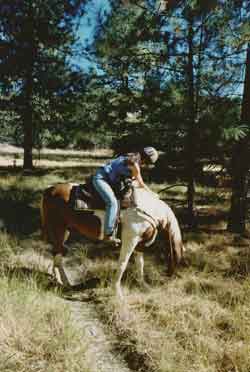
|
 |
Terrain: Mostly single track trails, some loose dirt, some packed, rocky; many dirt fire roads; several hard climbs and descents; 4,500 elevation.
Difficulty: Rider: intermediate and beyond; horse: experienced
Facilities: Large space for camping with 50+ corrals; water, no hook-ups; large open area for day-use.
Operating times: Open all year; not advisable during snowfalls which can happen October through May.
Cost: Campsites per night - $15 per rig; Horses and dogs - $1 each per night; Day use – Adults, $2, dogs and horses, $1 each. First come, first served except for groups of 12 or more rigs which can call for reservations: 1-800-234-PARK.
Directions: From I-10 in Beaumont, take Highway 79 south to Hemet; left at Ramona Expressway to Highway 74; left on Hwy 74 uphill for ap. 15 miles to McCall Park entrance on the left. Watch for the small sign just after you get into pines. The mountain road is slow and windy, with several turnouts. It is very safe, just slow. From I-215 in Temecula, go north to Hwy 74, exit east through Hemet and up the hill to McCall Park. |
| |
|
| ~ March 13, 2009 ~ |
 |
 |
Ray Hunt
Master of Communication
August 31, 1929 - March 12, 2009
Ray Hunt was born August 31, 1929 in Paul Idaho to parents Joel Eugene Hunt and Zua Stella Shangle Hunt. The family moved to Mountain Home, Idaho in 1933. Ray attended Mountain Home schools and worked with his father on the family farm. Ray married Millie Randall in 1948. In 1950 they moved to the Battle Mountain, Nevada area where Ray worked as a cowboy for the T Lazy S ranch. In 1955 the family moved to California. Ray continued working with horses becoming famous the world over for his pioneering methods. Ray married Carolyn Lord in 1980 at Georgetown Lake, Montana. The clinics grew to epic proportions with Ray helping people and horses both domestically and internationally. Ray often earned recognition for his achievements including the Top Hand Award, being inducted in to the California Reined Cow Horse Hall of Fame in 2004 and being named the first Western Horseman of the Year in 2005.
Ray passed away March 12, 2009 in Denton, Texas after a long and courageous battle with COPD. Ray is survived by his wife Carolyn and daughters Geri Van Norman of Tuscarora Nevada, Kathy Hunt of Salinas California, Elaine Black of Homedale Idaho and Julie |
Ristau of Kodiak Alaska, and sons Joel Hunt of Bruneau Idaho and Preston Lord of Mountain Home Idaho, eighteen grandchildren and 2 great grandchildren. Ray was preceded in death by his parents, two brothers, two sisters, 1 grandson and 1 great grandson.
A memorial and celebration of Ray’s life will be held March 21, 2009 at the Oak Valley Ranch in Era, Texas at 1:00 p.m. Open to the public. Please visit www.rayhunt.com for more details.
A memorial and celebration will be held March 28, 2009 in Mountain Home, Idaho with the time and venue to be determined. Please check back here for updates. Open to the public. A memorial and celebration will be held in Australia with details to follow. Please contact Bill Geddes, (Brookfield) Tarooma, (07) 4628 3257. |
 |
For those that would like to send cards please do so at the following address:
Carolyn Hunt
9698 E Hwy 20
Mountain Home, ID 83647 |
In lieu of flowers, donations should be made to the Ray Hunt Memorial Fund administered by the Capital Area Therapeutic Riding Association. It will be used solely in support of programs dedicated to horseback riding for people with disabilities. Ray was impressed by how the horses were able to impact people with disabilities in such dynamic ways and this program really meant a lot to him. All donations are tax deductible. For more information on CATRA please go the website: catra.net or contact Ben Nolt 717 – 649 – 9822. Capital Area Therapeutic Riding Association, Inc. is a Not-For-Profit Organization Recognized by the Internal Revenue Service.
Please note: We will fill all merchandise orders after we complete our family business and have had time to grieve.
|
|
| ~ February 17, 2009 ~ |
The Saddle as an Adapter
Presented by: Zsuzsu Illes
Independent Saddle Fitter |
 |
What is the number one point we must keep in mind when fitting a saddle for a horse and a rider?
Answer: The saddle must fit in motion. When the saddle works as an efficient adapter in motion it helps both horse and rider move together in harmony. A saddle must allow for both the horse’s back and the rider’s back to move correctly to set the stage for harmony.
Let’s take a look at the horse’s back and the variables we need to take into account.
* Our primary goal is for the horse to pick its back up and carry us rather than move us around. A horse can only accept and carry the rider’s weight when his back is relaxed.
* The horse’s back is its source of all movement. Without the ability to use its back efficiently for movement the horse will move in a manner that creates pain for both himself and his rider.
* A horse that is relaxed is better able to balance himself under the rider. This allows the rider to sit more comfortably and be able to absorb the horse’smovement correctly. In turn this allows for correct and efficient aiding.
* A saddle that impinges movement or creates pain and discomfort creates a hollowed and/or tense back. Once again, this creates pain for both horse and rider.
* Riding a horse whose back is hollowed or braced against the saddle and rider contributes to the breakdown of its connective and supportive tissues.
* Riding a horse with a hollowed or braced back creates tension in and bracing of the rider’s back. This creates back problems for riders as well as hip and knee problems. |
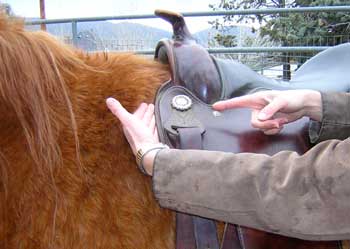 |
In terms of training and performance, the horse needs to be able to use his back to maintain his balance while keeping the correct rhythm of the gait he is in. Using his back freely and correctly also allows the horse to reach under his center of gravity with each step, which has him moving athletically and efficiently. In addition, what we may believe to be training or disobedience issues with our horses are instead very often saddle fit issues. This can then create a cycle of frustration and misunderstandings between horse and rider.
So what are we looking for in saddle fit with these points in mind?
The topside of the saddle must fit the rider’s pelvis shape and size,his/her leg shape and length and allow the rider to sit in balance while in motion on the horse. |
| |
 |
The underside of the saddle must allow for shoulder freedom and back movement of the horse, as well as the most weight disbursement of the rider across his back muscles. The saddle must also protect the horse’s spine and connecting tissues as well as not bear weight on his loin area.
Often times, because the rider or the horse has changed, or the saddle has changed shape or size in combination with a worn-out pad, a once well fitting saddle will no longer fit. Often we are unaware of the changes that have taken place and we look elsewhere for solutions to problems we may be experiencing. Experts agree that saddle fit should be checked every 6 – 12 months.
Following are some signs of bad saddle fit for both horse and rider. |
| |
 |
For the horse:
* Sore Back - White spots on coat - Muscle atrophy on back
* Girthy or fidgety while being tacked
* Will not stand while being mounted
* Behavior issues that cannot be solved through changes in training
* Behavior changes from sweet to grumpy as soon as tack is brought out or tackingbegins.
* Cannot concentrate on rider, spooky
* Rushing downhill or towards jumps
* Tripping or stumbling
* Unable to round back or use hind end
* Unexplained lameness
* Cannot move to next level of performance |
| |
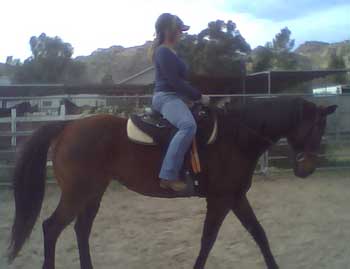 |
For the rider:
* Insecure feel in saddle
* Upper and lower back pain
* Seat, hip and/or knee pain
* Difficult or impossible to maintain balanced, aligned position
* Seat, legs and hands cannot work independently
* Struggling to sit back or to come forward in the saddle
* Cannot move to next level of riding skill
Trying to determine on your own if your saddle fits can be frustrating and quite difficult. It is often best to request the help of a saddle fitter, whether it is the area representative for the manufacturer of your saddle or an independent saddle fitter. |
For more information about saddle fitting visit:
Independent Saddle Fitter
or call 818-427-9733 |
|
| ~ January 1, 2009 ~ |
COMPASSION, INTUITION AND HEALING
By: Alina Milan, Certified E.B.W. |
 |
Exploring Intuition and Mindfulness
Intuition is not enough. It is not enough to simply think that the heart or feelings will lead you because with this thought quite often one is being led by their own needs and results.
Having a clear understanding and knowledge of the specific subject, in this case, Equine Body Work, learning all of the "left brain" things, such as anatomy, gait work, conformation are extremely important because the confidence of knowledge opens you up to live more freely in the right brain, while also living in the now. |
A Story About John
This story illustrates the different ways each person deals with an emotionally traumatic experience. I feel it is important because a health professional must be able to assess each person's or horse's comfort level without judgment. One must hold themselves outside of the emotional bubble and yet still remain attuned and compassionate to facilitate the healing.
John was a friend of mine. When they called us from the hospice where John was staying, we knew it was time. There were four of us. We could hear him breathing before we opened the door. He was lying in bed staring straight ahead. His arms were at his side. He was panting out of fear.I think. He never looked at anyone. He just stared straight ahead. He looked very small.
Two of his friends sat on the bed on either side of him. His other friend sat at the back of the room. Right up close to the wall. He never moved. I was at the foot of the bed. I don't think John could focus on us. I don't think he could die and be with us at the same time.
The sound was everywhere.his breathing.ragged and deep. Like a mantra. His two friends began to act silly. Saying stupid things, telling dirty jokes. They began putting things on John's head: a paper cup, a napkin. They found a pencil and stuck it through the cup, still balanced on his head. The cup teetered from side to side.
I held my breath. Clenched my teeth. John kept breathing. The walls were breathing and the others kept laughing. They were supposed to be his friends. What right did I have to say anything? I doubted myself. Why didn't I do something? Say something. I wanted to scream. To take him and run.
John kept panting. Someone suggested that we call his parents. That maybe that would help him and then you were on the phone. His mother. When he heard your voice, his body gave in. He relaxed. All he needed was to hear your voice. To hear his mother, mom, mommy say, "There, there, it's alright. I love you, Son. I love you sweet boy." It's all he ever wanted. And I realized that in the end it doesn't matter what kind of mother you are, whether you are cruel, judging, unforgiving or sweet and warm and loving.all any of us ever really want is for our mother to say, "I love you. It's alright."
One of his friends got off the bed and left the room. His other friend started sobbing, pawing at John. John's nurse took him outside. I knew it was time. I realized why we were friends. That I was the one who was supposed to help him out of this world. I went to him. I told him that I loved him. I said, "Take my hand, John, It's time to go. Okay. Let's go." For a moment, I panicked. Is this right? Is it time? And then I looked at him and said, "Come with me. We'll go out there and we'll fly around. It'll be so beautiful. I'll go out with you as far as I can. I won't leave you. I promise. I love you. Come on, let's go."
He took a deep breath and then turned and said something. I missed it. He squeezed my hand. Like a breath being caught and then blown away. He was gone. Not a sound. And then it seemed that the room was filled with millions of particles of John, sparkling,
floating, falling on my skin, in my hair, on my eyelashes. I breathed him into me.
Then I washed his body. I touched his skin, his face, closed his eyes. I dressed him. Do you know that he always slept in a suit? It's important that you know that he was loved. I loved your son. He was important to us. He had worth. He was somebody. He taught me to trust myself. He taught me how important it is to be selective. To surround yourself only with people that you trust with your heart and soul. This may sound strange to you but there have been times since he's been gone when I've been scared and alone and I feel him come to me. I felt his presence. I loved your son. He gave me the greatest gift of all, himself, and he broke my heart at the same time.
In memory of John and all of the other abandoned Sons, I continued to work in hospice care while living in San Francisco.
Being in the "now" is very challenging on any given day, but is especially so when one is working through a trauma with another being. It is as though one must slide an imaginary shade between the emotional situation and one's own emotional needs so that you can continue to view the situation viscerally, acting from intuition, compassion and mindfulness.
In the above example, each person in the room became my teacher. As it is when working with horses, often they will show you where you need to go. However, if one is not able to listen, it will be a missed opportunity to facilitate healing or building trust for future treatments. |
Understanding the Emotional Differences of Horses
The important of recognizing the emotional differences of horses, as with people, is necessary in order to modify specific modalities. For example, head-shy horses, while they may need MFR (myofascial release) work cranially, may also not be open to the work. Therefore it is the therapist's job to be able to identify another way in.
In such cases, who is the teacher? The horse? The owner? The massage therapist? Perhaps all of them. To remain open, it is important not to judge the horse, the client or one's self. Sometimes the best way to a horse is opening up to the owner or handler.
|
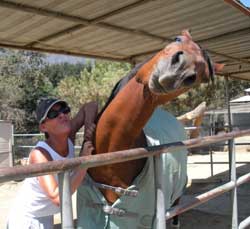 |
Linda Tellington, through her studies on horse's personalities, shares another way of "feeling" and "understanding." Is this her way of also acknowledging the uniqueness of each horse's "spirit?" I think so.
Tom Dorrance discusses it in his work when he describes the third piece. "The rider needs to recognize the whole horse," he writes. "This includes the physical and the mental.and a third factor. It is the least mentioned but I am beginning to believe it is the most important.Spirit."
Additionally, he notes that "people have to rely on themselves. I tell people that it has to come right out of the inside of themselves. There can be some direction, or support and encouragement, but the FEELING itself can come from no one but themselves."(True Unity)
Maybe all of this is obvious to others.just as it is to me until a stress, a bad day, suddenly knocks me out of myself - losing that balance which enables me to feel, listen closely and intuit. Suddenly, like most people, I am drawn into the race for results. I've found the key is to recognize that we have slipped off the path.
Explaining the "Feel"
How do you explain the "feel" to others? The transitions between left brain and right? I feel that it is a state of grace.an in-between place like empathic work.
The work with my friend John taught me to travel between the two places; to be with someone else with the intent to "do no wrong." What is important is to know what is specific for a person or an animal. The goal with this work is:
· To find true understanding in the moment
· To facilitate healing
· To assist in learning
· To comfort in death
A while ago, I was talking with my veterinarian about the stray puppy I found, and as the dog was squirming away from him in fear, his voice dropped to "sing-song" and then he sat down on the floor Buddha-style, and continued talking to her. She looked back at him and slowly walked to him. "They're all just looking to be loved," he said. We then talked about school and all that I learned, bones, muscles, modalities, and he stopped me and said, "All of that is great, but the most important thing of all is compassion. Because where there is compassion there is love." He continued to talk of his practice and medical school and of all the extremely talented clinicians that he had worked with, but the ones who really stood out understood there was another piece to healing, teaching, caring for others.the ability to have compassion.
When I treat my human clients, before I can create a workout plan, first I must take in the person in wholeness. Their strengths and weakness in the physical, as well as emotional, to begin to develop a plan. Before teaching an exercise, a modification of it may be necessary and without mindfully seeing the person I would be unable to adapt to where they were in the moment. Additionally, it is vital to know that people and animals are not the same in the next moment and the importance of staying open to what is rather than how it should be or the way it was before. |
Exploring Massage Modalities
In studying the different types of massage modalities, is one more effective than the other? And if it is more effective, for what type of physical/mental issue is it suited? However, before the "issue" is dealt with, the animal or human in its wholeness needs to be mindfully "seen." To "breathe" the human or animal in, to take in their physical and emotional personalities, not with judgment but as a way of building through empathy a pathway of communication to build trust and respect. |
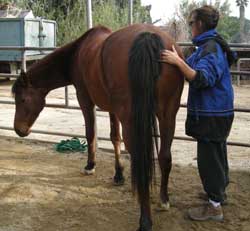 |
There are many different modalities of equine massage: myofascial release, craniosacral, Reiki, acupressure, deep tissue, sports, energy work and within these there are different styles and approaches. Yet to me, the true challenge is to remain open to all things while holding on to your intuition.
A case in point: One day, my horse Lacy and I worked with a trainer and the outcome was disastrous. I realized that while there are different schools of thought regarding horse training, this particular style was definitely not working for us. Why had I allowed this type of training to go on? Why hadn't I listened to myself and my horse? Her behavior had changed.she was definitely not a happy horse. And neither was I happy. It seems I had become lost in the "shoulds" and "results" of the work and had lost sight of the very thing that I had been seeking: harmony with my horse. I had lost the grounding within myself; my intuition, and without it I had lost my power of listening.
The guilt that I felt and still feel for letting my horse down was terrible. How have I found myself in this situation? How could I have lost my center? I should know better. But
that's the thing, the lesson for me is that there is a delicate balance in the pursuit and upkeep of the spirit. As a facilitator, one must never lose sight of this when it comes to our human and animal clients..
One never arrives with all the answers and if you think that you know something beyond a doubt then the window of compassion and intuition closes. These are necessary and are in fact essential in practicing any modality. Without these, one cannot truly assess the person or an animal. I believe that when compassion and intuition are involved love is present. Love is the door to the soul.
It should be noted that although compassion and intuition are essential tools to facilitate healing, technical knowledge is also extremely important. Perhaps compassion is the link
Teachers, Muses and Such
I have had the privilege of studying and working with some extremely gifted people. The two who have had the greatest impact on me were Martha Graham, one of the pioneers in modern dance, and Stella Adler, also a pioneer in creating a method of stage and film acting.
What I got from both of these women was their unflinching ability to seek the truth in the voice of their craft. Although both were extremely talented in their respective disciplines both must have known that it wasn't enough. It was their constant quest for new skills, developing the art of sensitivity through understanding the beat of the heart in all things, celebrating life and death in their work, honoring the spirit above all else, childlike curiosity, technique and skill through study, seeking to understand human-ness without judgment, delving into ones' emotional abyss, and above all else, fearlessness in searching for the truth in a word, in movement, in a moment and in life itself. Acknowledging that it is living in the moment which we all strive for and that which gives us the most clarity.
If I had to put a name to all of the above it would be passion. For, without passion, all action is flat. Is this why horses draw so many of us in? Their passionate, powerful, energy? Or is it simply the Spirit of the Horse.
Last year, I attended Equine Affaire and watched Linda Tellington-Jones demonstrate how to ground a spooky, fearful horse. After the demo, I had the privilege of talking with her on the subject of equine behavior, most especially how to ground an un-grounded animal. We talked of specific massage and ground techniques but that which became the through line of working and reaching a fearful horse was working from the heart. The heart connection.
Once again, while perhaps education, knowledge, acquired skill through study is extremely important, it seems that those driven by their passion and love of the
horse/human bring a deeper level of connection through their commitment and understanding that to facilitate change - respect, compassion, and heart is essential.
Additionally, while I have not had the chance to work with him directly, I am in awe of John Barnes, his work and his courage to have followed his vision no matter what so that I might now learn and delve further into myofascial training.
With each new step we take, as with the horse, it is this first one, fresh, new and without the past, which gives us the truth.
For more information about Alina Milan,
please visit her website at
www.softnickers.com |
|
|
| |
|
|